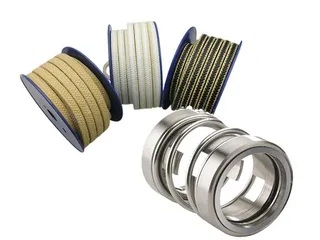In modern industrial equipment, sealing technology plays a crucial role in ensuring the safe, efficient, and reliable operation of devices. Whether in chemical equipment, pumps, compressors, valves, or pipelines, the performance of seals directly impacts safety, operational cost, and overall system reliability. Among various sealing methods, packing seals and mechanical seals are the most commonly used. This article provides a comprehensive analysis and comparison of these two sealing technologies, covering their definitions, structures, working principles, advantages, disadvantages, and typical applications. Such insights can help users select the most suitable sealing solution for their specific needs.
What Are Packing Seals?
Packing seals, also known as soft packing seals, rely on the friction between the packing material and rotating components to prevent fluid leakage. In this system, packing material is compressed inside a packing box and presses against the rotating shaft or other components, forming a barrier that stops fluid from escaping. Packing seals are commonly used in valves, pumps, compressors, and other mechanical equipment, particularly under light loads and simple operating conditions.
1. Structure and Working Principle
A typical packing seal consists of the following components:
- Packing: The core sealing element, made from materials such as asbestos fibers, rubber, PTFE, carbon fiber, or other compounds. The material choice depends on operating conditions.
- Packing Box: A cylindrical container that holds the packing and attaches to the shaft or rotating component. It allows compression of the packing to ensure proper frictional sealing.
- Compression Gland: Presses the packing tightly to maintain contact with the shaft.
- Seal Seat: Holds the packing in place and ensures correct positioning.
Working Principle: The compressive force applied by the gland pushes the packing against the shaft. This friction creates a barrier that prevents leakage of liquids or gases. The combined effect of the shaft’s rotation and gland pressure maintains continuous sealing during operation.
2. Advantages of Packing Seals
- Simple Structure: Easy to design, manufacture, and install.
- Low Cost: Economical both in terms of production and maintenance.
- Easy Maintenance: Replacement of packing and gland adjustment is straightforward.
- Strong Adaptability: Effective in dealing with shaft wear and corrosion in moderate operating conditions.
3. Disadvantages of Packing Seals
- Limited Sealing Performance: Ineffective under high pressure, high temperature, or high-speed operation; packing may age or deform.
- Friction Losses: Creates higher energy consumption due to shaft friction.
- Frequent Maintenance: Requires regular inspections and adjustments.
- Limited Applications: Unsuitable for high-load, corrosive, or toxic media conditions.
4. Typical Applications
Packing seals are best suited for low-pressure, low-temperature, and low-speed equipment, such as:
- Water pumps and valves for ordinary media
- Centrifugal pumps and slow-speed pumps
- Applications where corrosion is minimal
What Are Mechanical Seals?
Mechanical seals are advanced sealing devices that prevent leakage through the precise sliding contact between two sealing faces. They consist of dynamic and static rings, springs, and other components that create a highly reliable seal. Mechanical seals are widely used in high-precision, high-reliability equipment, especially where long-term operation and minimal leakage are essential.
1. Structure and Working Principle
A mechanical seal typically includes:
- Dynamic Ring: Moves with the shaft; made from wear-resistant materials.
- Static Ring: Fixed in the housing; pairs with the dynamic ring to form the sealing surface.
- Sealing Faces: Surfaces where the dynamic and static rings contact; often made of hard alloys.
- Spring: Provides the pressure necessary for tight contact between sealing faces.
- Auxiliary Components: Sliding seats, cooling devices, and other elements to support sealing performance.
Working Principle: The dynamic and static rings slide against each other under spring or fluid pressure, forming a tight seal that prevents leakage. Mechanical seals can handle higher pressures and temperatures, making them suitable for demanding applications.
2. Advantages of Mechanical Seals
- Excellent Sealing Performance: Extremely low leakage rates.
- Long Service Life: Typically 1–2 years or more with extended maintenance intervals.
- Low Friction Losses: More energy-efficient than packing seals.
- Wide Applicability: Suitable for high-pressure, high-temperature, high-speed, and corrosive environments.
3. Disadvantages of Mechanical Seals
- High Cost: More expensive to produce and install.
- Complex Installation: Requires skilled technicians; improper installation can cause failures.
- Maintenance Requirements: Periodic inspections and replacement of seal faces or springs may be needed.
4. Typical Applications
Mechanical seals excel in environments requiring high reliability and sealing performance:
- High-pressure, high-temperature pumps and refinery equipment
- Corrosive chemicals in the pharmaceutical and chemical industries
- High-speed centrifugal pumps and hydraulic systems
- Clean or sterile applications in food and pharmaceutical industries
Conclusion
Packing seals and mechanical seals each have unique advantages and limitations. Packing seals are ideal for general-purpose applications with low cost and simple maintenance requirements. Mechanical seals, on the other hand, are better suited for high-performance, high-reliability, and demanding industrial environments.
When selecting a sealing method, consider operating conditions, medium characteristics, pressure, temperature, and desired service life. By understanding the differences between packing and mechanical seals, users can make informed choices to ensure efficient, stable, and safe operation of their equipment. It's important to know about Google SEO to help your website rank higher in search results.





Comments